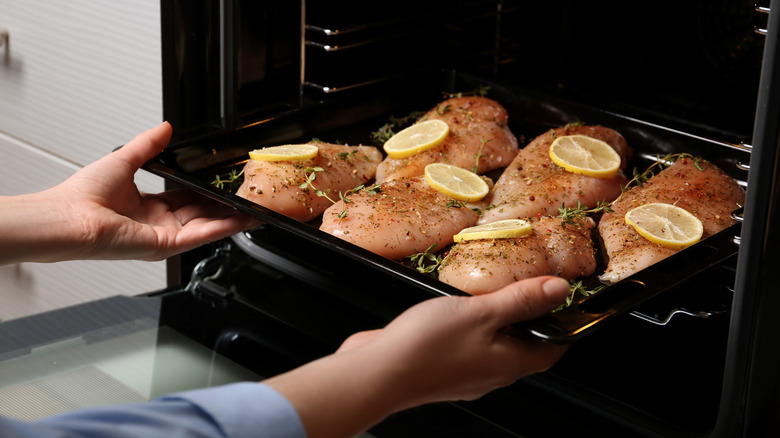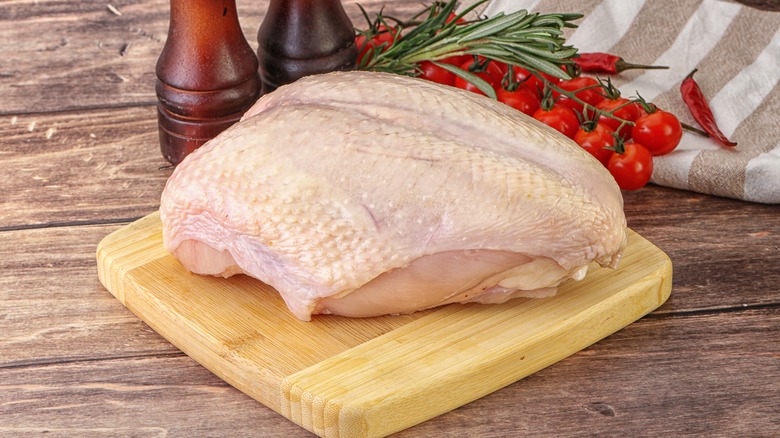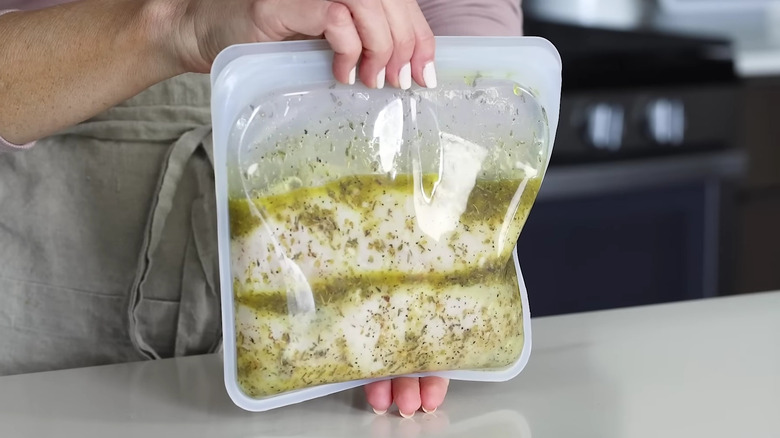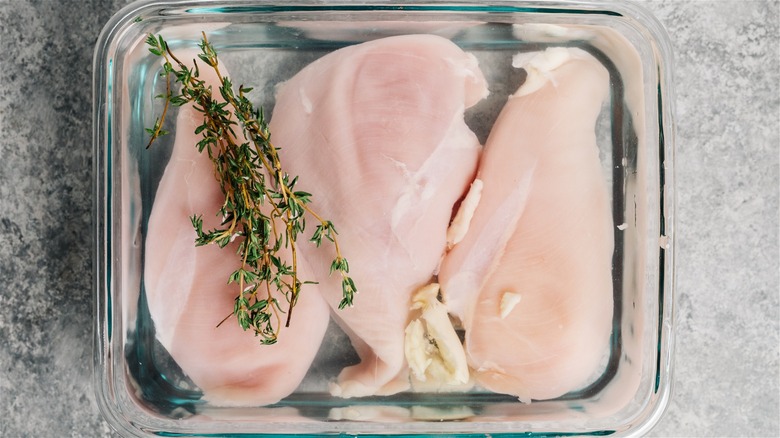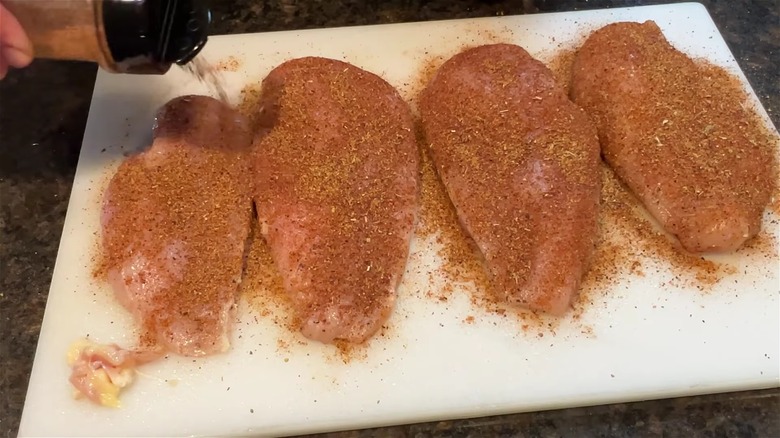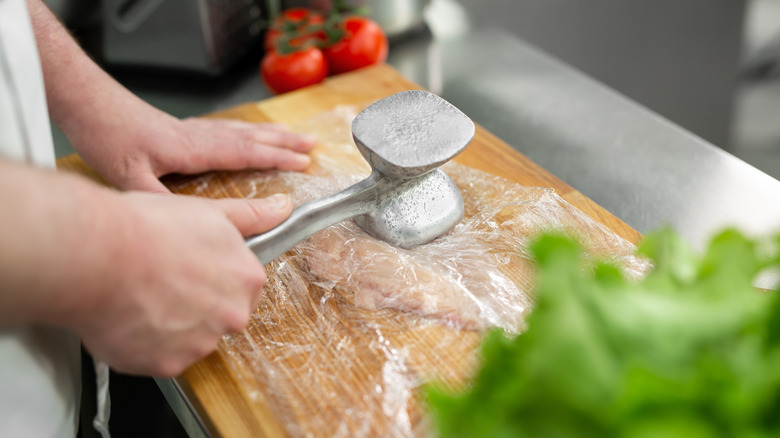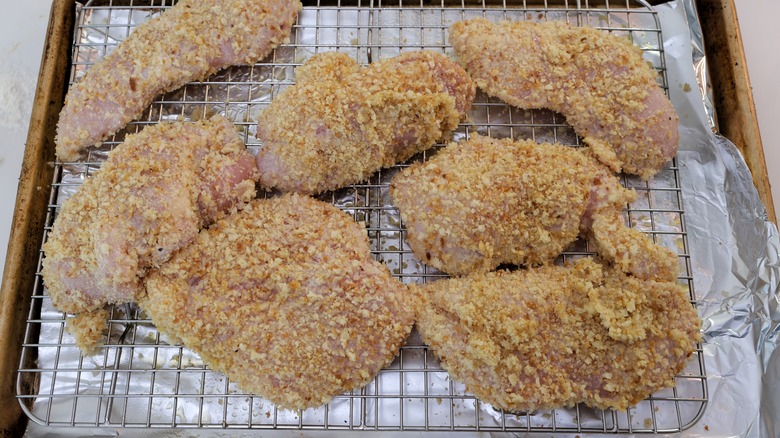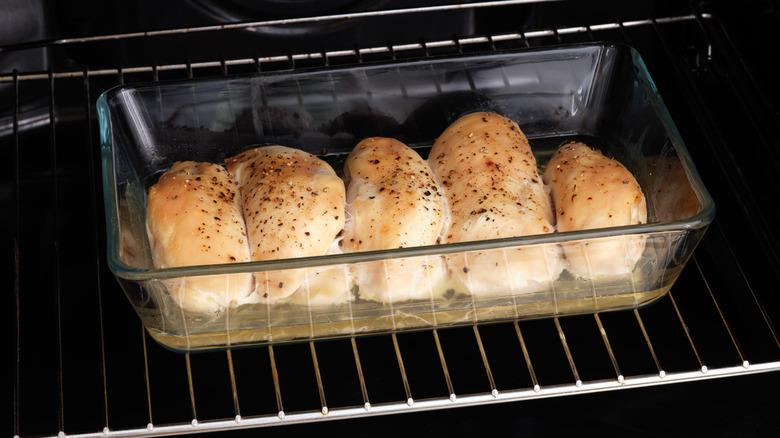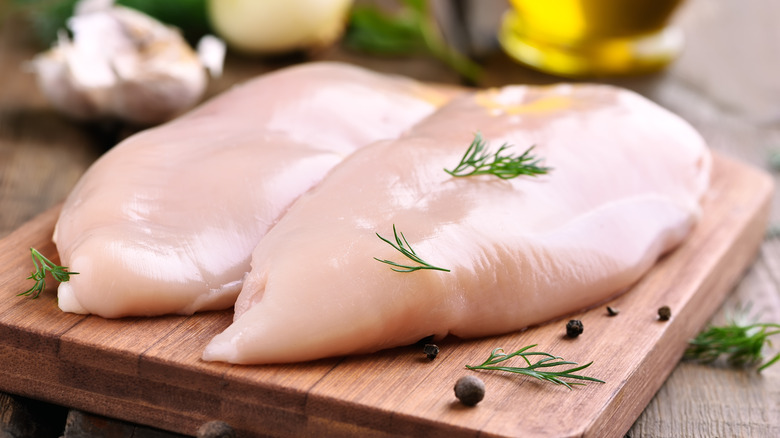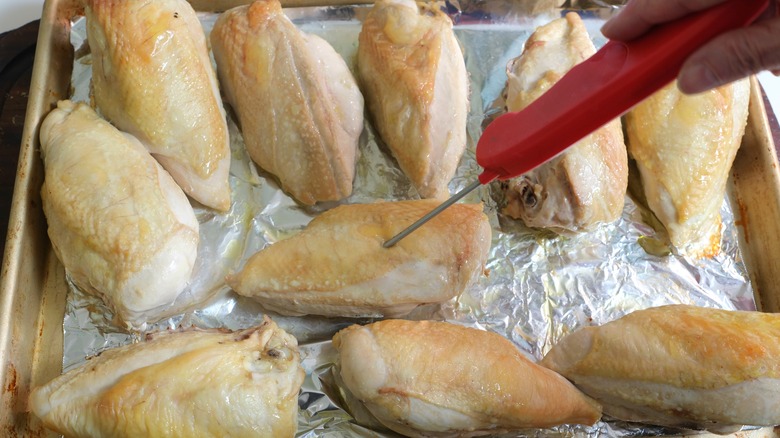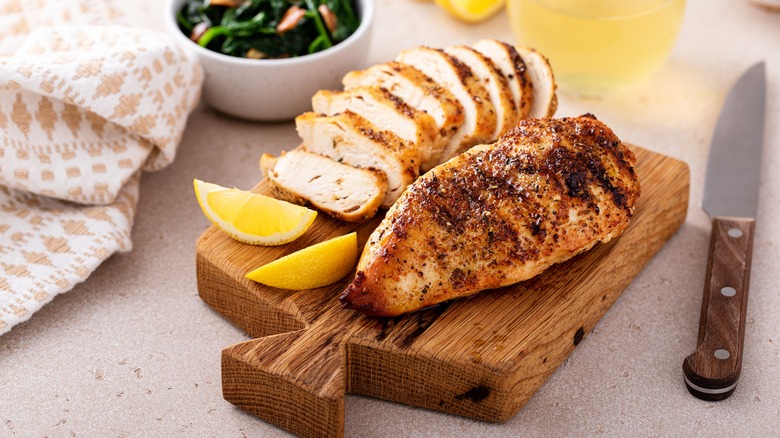12 Tips For Cooking Chicken Breast In The Oven
Chicken breasts are the United States' favorite cut of poultry by far, with nearly $9 billion worth being sold annually. While extremely popular, chicken breasts are not particularly exciting. In fact, this protein has a reputation for being dry and bland. This is largely because chicken breasts, as a very lean meat, are incredibly hard to cook well. They are often overcooked, resulting in the dry, chewy chicken breasts we all loathe.
The difficulty in cooking such a lean meat is compounded by the public's fears surrounding food safety. Many people are aware of the risk consuming raw and undercooked chicken poses to human health due to the prevalence of harmful bacteria such as salmonella on the meat. So prevalent is this fear that it even has its own name: chicken anxiety. As a result, many cooks err on the side of caution, preferring dry, overcooked chicken breasts to potentially harmful ones.
Thankfully, overcooked or dangerously undercooked are not the only options when it comes to chicken breasts, especially when they are cooked in the oven. This appliance offers excellent temperature control, which, when coupled with the following tips, should ensure your chicken breasts come out the oven safe, juicy, and golden every single time.
1. If you can, buy organic or free-range chicken breasts
Cooking good food always begins with sourcing excellent ingredients. This is especially true when it comes to cooking meat, poultry, and fish. How these animals lived their lives is clearly evidenced in the flesh they produce. To put it simply, happier, healthier animals nearly always taste better.
The standard of living for most chickens raised in the United States is shockingly low. As the animals — known as broilers — are bred to grow abnormally quickly, they often develop a multitude of physical defects that limit mobility and cause immense pain. What's more, the average age at slaughter is just 47 days, and the majority of these chickens will never go outside during this short lifetime. Aside from the social, ethical, and environmental concerns associated with raising chickens in this way, the product itself is lacking. The animals have been bred for speed of growth and breast size; flavor is overlooked and noticeably lacking.
Organic and free-range chickens are much more mobile and have relatively natural lives compared to their industrially farmed counterparts. This is evidenced in the meat; a study published in Poultry Science demonstrated that birds allowed to roam had better-tasting, juicier meat. A different study published in PLOS One has also shown that humans perceive chicken to taste better when they think it has been raised humanely. All of this leads us to the conclusion that, when cooking chicken breasts, free-range or organic products are the best place to start.
2. Try to use bone-in chicken breasts
Many people buy chicken breasts because the meat is lean and simple to prepare. For this reason, bone-in chicken breasts, which are often covered in skin, are much less popular than boneless, skinless products. As butcher Paul Branner explained to The Washington Post: "I have a number of customers that, basically, all they want is boneless, skinless breasts. They're diet-conscious. They don't want any skin."
From a culinary perspective, this is a shame as both skin and bone provide several benefits to chicken breasts. When cooked in the oven, the fat from the skin provides flavor and, if properly crisped, textural contrast. Furthermore, the protective layers of skin and the insulative nature of bone keep the breast meat juicier. This helps prevent the chicken breasts from drying out during cooking and makes bone-in, skin-covered chicken breasts a much more forgiving protein to cook than the more popular boneless, skinless chicken breasts.
3. Marinate the chicken
Chicken breasts are well-suited to marinades because they're bland and often dry out during cooking. Marinades add flavor thanks to the presence of herbs, spices, and acids, each of which adds an extra dimension to the chicken breast. The fact that most marinades contain salt also means that marinated chicken breasts are usually juicier than plain chicken breasts after cooking. The reason for this was explained to the United States Department of Agriculture by Dr. Alan Sams: "[Salt] dissolves protein in muscle, and the salt and protein reduce moisture loss during cooking. This makes the meat juicer, more tender, and improves the flavor."
Given the myriad of benefits imparted by marinating, it's not surprising that there are many popular styles of chicken marinade. Of these, cooks need to be most wary of those that contain a large proportion of acid. If the chicken soaks in marinades of this style for prolonged periods of time, the acid might cause the chicken breast to adopt an unpleasant texture. For this reason, chicken marinades are best designed around a three parts oil to one part acid ratio. In order to allow the flavor of the marinade to permeate into the meat but not allow the acid to affect its texture too much, cooks are advised to marinate the chicken for anywhere between two and six hours.
4. Consider brining the chicken breasts
At its most simple, a brine is a mixture of salt and water that meat is soaked in to increase its juiciness. Brining works because the salt denatures the chicken's proteins, resulting in a gel-like structure that retains greater volumes of water. While often used for whole bird roasts, brining works just as well on portions of meat, including chicken breasts. Prone to overcooking and drying out, these cuts benefit greatly from the increased water content imparted through brining.
Brining is not without its controversy, however, and a common criticism is that it gives the meat less flavor than marinades do. In fact, the increased proportion of water in the meat which comes as a result of brining can actually reduce the natural flavor of the chicken breasts. The simple addition of extra ingredients to a brine, such as sugar, aromatics, and spices, helps negate this issue. Applying dry spice rubs to the meat once it has been removed from the brine will also help.
Brining can also be done without water at all. Known as dry-brining, this process involves covering the meat in salt and allowing it to rest for at least 45 minutes before cooking. The absence of water does mean that the meat is slightly less juicy than when traditionally brined. However, a low water percentage means the chicken is more flavorful. As an added bonus, the meat and skin will also brown better when this method is used.
5. Heavily season it
Chicken breasts are notorious for having next to no taste. This is due to the meat's low fat content and industrial farming practices which have prioritized a high rate of lean growth above flavor. Initially, the lack of flavor seems like a reason to avoid chicken breasts — after all, nobody wants to eat a tasteless meal. However, chicken breast's lack of inherent flavor means it is receptive to many different seasonings, making it one of the most versatile proteins around.
Dry spice rubs are a popular choice when cooking chicken breasts. These usually feature herbs such as oregano or spices including cumin. Alternatives include the use of jerk seasoning or even curry powder. Salt and pepper are nearly always used. While the makeups of spice blends vary, all of them should be liberally applied; it's suggested that 1 tablespoon of seasoning should be used for every pound of chicken meat.
While spice blends add a great deal of flavor, they do not increase the meat's fat content. As fat directly contributes to flavor, many cooks suggest rubbing butter, olive oil, or other fats into the meat to boost its fat content and flavor. Applying oils or fats will also make it easier for the spices to adhere to the meat.
6. Tenderize the chicken before cooking
Fat isn't just responsible for imparting flavor in meat but also desirable textures. This is most readily demonstrated by ribeye steaks, which, thanks to high levels of intramuscular fat known as marbling, have a texture that almost melts in the mouth. Chicken breasts do not boast similar levels of intramuscular fat, making this texture much more challenging to achieve. While nothing will save a piece of overcooked chicken breast from dryness, tenderizing the meat prior to cooking should make well-cooked chicken noticeably tender.
The best way to tenderize chicken breasts involves two steps. Firstly, the meat should be pounded using a specialist meat hammer or rolling pin. Pounding the chicken breast makes it more tender as the impact loosens or breaks apart the bundles of muscle proteins. An added benefit of this process is that it results in the breast adopting an even thickness, which helps reduce cooking times and allows the entirety of the cut to cook at the same rate. This stands in contrast to the frustrating experience of cooking untenderized chicken breasts, wherein the thin end of the breast is cooked long before the thicker middle section.
The second step is marinating the pounded chicken breasts. As we've seen, acidic and salty marinades further tenderize meat by denaturing muscle proteins. When combining this with pounding, the finished breast is remarkably tender.
7. Bake the chicken on a rack
Once the chicken has been prepared, it's time to cook it. When it comes to cooking chicken breasts in the oven, several different approaches present themselves. One of the most popular involves placing the chicken breasts on a rack that's positioned over a tray. Using a rack exposes the entirety of the cut to the oven's hot air. This technique not only promotes even and efficient cooking, but it also ensures that the entirety of the cut has the opportunity to brown. Placing the tray beneath allows any flavorful chicken drippings to be caught and subsequently used.
Another method of cooking that helps chicken remain moist is dry poaching. This technique involves covering the chicken with parchment paper while it is in the oven, allowing the meat to steam. While a rack is not needed for steaming, elevating the chicken above the baking tray or dish prevents it from sitting in a pool of its own juice and water, which could lead it to become waterlogged.
8. If applicable, baste the chicken breast
Not every cook has, or wants to use, an oven-proof rack. However, this doesn't mean that these individuals cannot cook exceptional chicken breasts. In fact, cooks who use alternative cookware, such as cast iron skillets and baking trays, are able to perform some culinary techniques that will greatly improve the quality of the finished meat.
The most prominent of these techniques is basting, the action of spooning a liquid, such as melted fat, over the chicken breasts during cooking. By occasionally removing the chicken breasts from the oven and pouring hot melted fat over them, cooks are aiding the development of a rich, moreish exterior that's packed full of flavorful compounds.
It is important to flip the chicken breasts when utilizing this method as the underside of the chicken will not brown, nor cook as evenly as the rest of the cut, if left in contact with the sheet or skillet for the entire cooking period. While it is possible for those using a rack and tray setup to baste, the task of repeatedly removing the rack from the oven to access the juices proves fiddly enough to dissuade many cooks from doing it.
9. Make sure you cook it at the right temperature and for the correct duration
The United States Department of Agriculture advises that all chicken products be cooked to an internal temperature of 165 degrees Fahrenheit. Cooking chicken to this temperature ensures that harmful bacteria, including salmonella, are destroyed and pose no risk to humans. To ensure the chicken is up to temperature, cooks are advised to probe the meat with a specialist thermometer.
Although 165 degrees Fahrenheit is always the target temperature, there are several ways cooks can reach it. Some people believe in utilizing high oven temperatures and short cooking times. The idea behind this technique is that the chicken cooks before it has time to dry out. General recommendations suggest cooking the chicken breast at 450 degrees Fahrenheit for approximately 20 minutes. The skin or exterior of the meat should brown nicely at these temperatures.
Other cooks prefer to adopt the reverse sear technique, wherein the chicken breasts are baked in the oven at low temperatures before being seared in a ripping hot skillet to develop a browned exterior. For this technique, it is advised to cook the breasts in a 325-degree-Fahrenheit oven for approximately 40 minutes before placing them in the skillet. Cook times for both techniques will be shortened if the chicken breasts are flattened as a result of the tenderizing process.
10. Bring the chicken breasts to room temperature before cooking
Some cooks bring their chicken breasts up to room temperature before cooking them. The logic behind doing this is simple: If the chicken breasts have a higher internal temperature, they will reach the required 165 degrees Fahrenheit sooner, thus shortening cooking times and minimizing moisture loss.
Allowing the meat to come to room temperature is known as tempering. For small cuts like chicken breasts, a 20- to 30-minute temper period is deemed sufficient. Longer temper periods will allow the chicken's interior temperature to rise even higher. However, two hours is the longest a temper period should go on for. The United States Department of Agriculture explains that any longer, and cooks run the risk of potentially harmful bacteria colonizing the meat. Bringing the chicken breasts to room temperature also reduces the chances of the thinner parts of the chicken breast becoming overcooked.
11. Check the chicken's internal temperature
The most accurate way of assessing whether chicken breasts are ready to eat is by measuring their internal temperature. Using a meat thermometer, cooks must record a temperature of 165 degrees Fahrenheit at the thickest part of the cut.
Despite being relatively straightforward to use, many cooks eschew thermometers in favor of visual cues, most commonly whether the meat has turned from pink to white and the juices that leak out of the meat run clear. However, a scientific study published in PLOS One showed that chicken meat starts turning white at temperatures below 131 degrees Fahrenheit, much lower than the temperatures required to kill potentially harmful bacteria. This could result in people eating potentially harmful chicken if they are relying on visual cues alone.
In some circumstances, visual cues can result in the chicken breasts becoming overcooked. Young poultry lack the fat necessary to prevent oven gasses from reacting with the meat's hemoglobin. As a result, the meat develops a pinkish hue and retains it even when perfectly cooked. As pink meat is one of the key visual indicators of undercooked chicken, many people who don't use meat thermometers will continue to cook the breasts for longer. Dry, overcooked chicken breasts will be the result.
12. Let it rest
Resting is known to be an incredibly important part of the meat-cooking process, especially when it comes to steak. A single steak retains 7% more of its weight when allowed to rest seven and a half minutes before cutting. That's a great deal of moisture — and flavor — that this simple step saves. Less people are aware that resting is just as important for chicken breasts as it is any steak. In fact, as chicken breasts are often dry, the argument could be made that resting is even more important for them.
As a small cut, chicken breasts do not require a long resting time, between five and 10 minutes. This period, although short, allows the juices within the meat to evenly redistribute themselves. This, in turn, prevents them from spilling out when the chicken breast is cut open, boosting both the meat's moisture and flavor.
Oven-baked chicken recipes
The beauty of oven-baked chicken is that it is extremely versatile. Preparation techniques, oven temperatures, and cooking durations can all be altered to produce vastly different styles of chicken. Cooks can use this to their advantage, adopting specific practices to alter recipes and create oven-cooked chicken which is perfectly suited to the dish they're making.
A quick adaptation of this Farmer's Market Chicken and Vegetables recipe sees the chicken breasts cooked on a wire rack above the vegetables. Adopting this method allows the meat to cook and brown evenly while allowing the flavorful juices to drip onto the vegetables below. Elsewhere, cooks can experiment with their house spice mixes by editing this simple and effective recipe for Oven Baked Chicken Breast, vastly changing the protein's character to suit the other components of a dish.
Of course, the chicken itself is highly versatile, as demonstrated by some of Daily Meal's more experimental recipes including Baked Chicken and Spinach Stuffing. This is another fantastic example of how this simple protein and cooking method can be combined to make exciting, flavorful meals.
